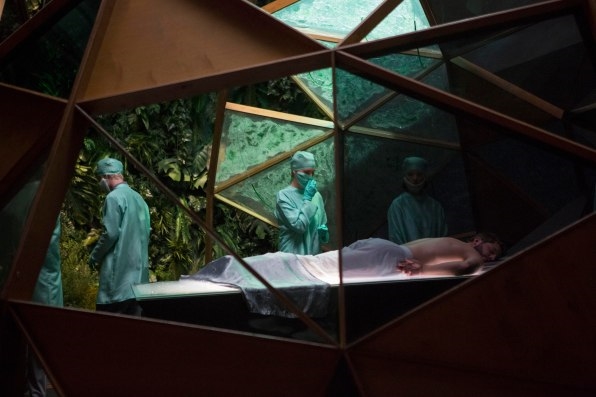How the director of “Upgrade” made a sleek sci-fi movie on a shoestring
Horror films are routinely lauded for their impressive ROI–they can cost next to nothing to make, yet have the potential to sweep at the box office.
Leigh Whannell is all too familiar with the business model, having co-created and written for both the Saw and Insidious franchises, which had total budgets of around $75 and $26 million and made $980 and $540 million at the box office, respectively.
As successful as Whannell has been in horror, he’s had an idea for a sci-fi movie that’s been percolating in his head for years: a quadriplegic in the near future whose paralysis is cured by a computer chip, giving him abnormal agility.
It’s a premise that could certainly carry a hefty price tag, and Whannell could’ve shopped it around at bigger studios. But in what can only be described as creative masochism, Whannell pitched his sleek, high-tech sci-fi thriller to Blumhouse Productions (Get Out, Split), knowing he would get a budget far below what his vision called for in exchange for creative autonomy.
The end result was Upgrade, a film with all the self-driving car chases, holographic surgeries, and glossy production design of a Hollywood blockbuster but at a fraction of the cost. (Blumhouse didn’t disclose an exact figure, but a spokesperson said the budget was under $10 million.)
Upgrade follows Grey Trace (Logan Marshall-Green), a man who’s been left paralyzed–and whose wife is murdered–after what seems to be a random attack. When a billionaire tech whizkid hears about Grey’s situation, he convinces him to be his guinea pig for STEM, a chip that’s surgically implanted on the spinal cord to give anyone who’s been paralyzed the ability to walk again. Once he’s fully mobile, Grey sets out to avenge his wife’s death which turns out to have been under circumstances beyond his ken. To make matters even more perilous, STEM starts to have a mind of its own.

“I was sketching out this story while I was working with Blumhouse on the Insidious movies, and I was seeing their model in how they built movies: They would get a filmmaker they thought was great and tell them, ‘we can’t give you any money, but we can give you total creative freedom.’ That’s a rare thing in the film industry,” Whannell says. “And so I had this idea: Can I make a movie in that model that is a big expansive sci-fi world and not just a horror film?”
Whannell did indeed achieve his goal but it was a process he describes as “a death by a thousand cuts.”
“The cuts I made to the film were not made with a machete–they were made with a scalpel,” he says. “I would go through the script page by page and line by line and take out my scalpel, and all of a sudden a line that I had written like, ‘the three guys rush at him and he takes them all out’ suddenly becomes ‘one guy rushes at him and he takes him out.’ Then I would take another look at it and say ‘. . . nobody rushes him and he doesn’t take anyone out.’ What ended up happening is that by stripping the movie back, it got better.”
For example, in the original script when Grey is getting his STEM surgery, Whannell had the operation done by robotic arms. In a pre-production meeting, however, he was convinced that might not be the best use of the budget. So instead, he had humans do the surgery but they had contact lenses that gave them x-ray like vision.
“The robot arms, they just weren’t as symbolic of this world I was trying to build. That’s too futuristic–that’s Bladerunner,” Whannell says. “This world is just around the corner. And so I think those little details like the contact lenses, they help remind you that you’re in the near future but it doesn’t go too far. It was kind of a happy accident that the budgetary constraints ended up honing the film down to more of a diamond. I look at it now and I’m like thank God I didn’t get those robot arms because it wouldn’t be as good of a scene.”

Whittling down the script helped to keep Whannell in check from not having tech in the film just for tech’s sake. Whannell says as he conceptualized what he saw as the future, everything had to serve a greater purpose to the plot, e.g. the self-driving cars.
In Upgrade, Grey is a mechanic who’s highly skeptical of all the autonomous technology around him. He drives and repairs regular cars even though his wife uses a self-driving one.
“I wasn’t putting [self-driving cars] in the script just to look cool. I was doing it because, to me, it was a metaphor for the character,” Whannell says. “Here you have this analog guy and he’s represented by this old analog car from the ’70s. And the automated car to me was a metaphor for how automation is taking away analog jobs. We’re designing ourselves into irrelevance.”
There have been many critically acclaimed and commercially sci-fi films that were made on shoestring budgets, like Moon, Ex Machina, or Another Earth. Where Whannell sees Upgrade fitting within that landscape is a return to the David Cronenberg-era of sci-fi–an era that’s was a little less cerebral and a lot grittier.
“My hope would be that this movie takes sci-fi back to a fun, tactile, grimy kind of lean and mean version of itself. What I’m harking back to are the sci-fi movies from the ’80s that I grew up with before the advent of CG, like RoboCop, Scanners, a lot of the Cronenberg stuff,” Whannell says. “The fact that they couldn’t do whatever they wanted in those films and they didn’t have computers to conjure up everything meant that they got so creative.”
Fast Company , Read Full Story
(32)



